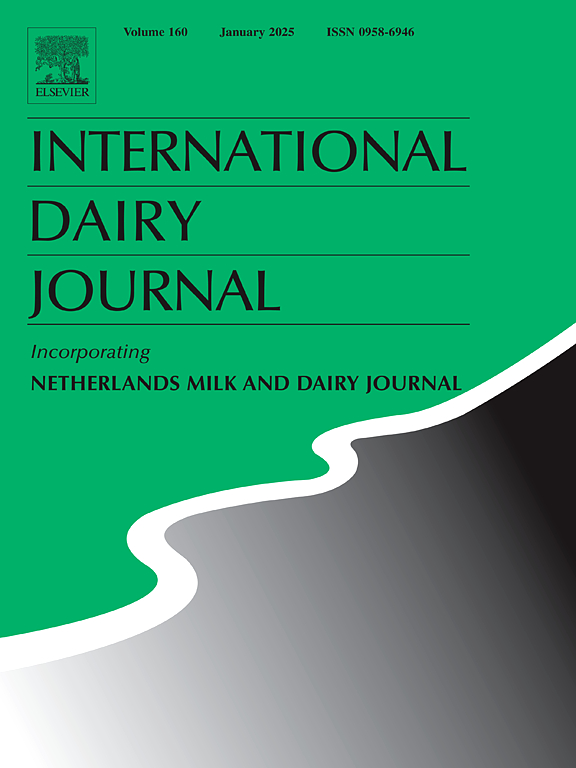Lipid profiles and microstructure of alpine Holstein milk: Comparison with common Holstein milk
IF 3.4
3区 农林科学
Q2 FOOD SCIENCE & TECHNOLOGY
引用次数: 0
Abstract
The lipid profile of cow milk farmed in Alpine region and their comparation with other regions in China are interesting but rarely studied. In this study, The lipid profile including total fatty acid, their sn-2 positional distribution, triacylglycerols (TAGs), phospholipid, and milk fat globules size, and microstructure in alpine Holstein milk (AM) and common Holstein milk (CM) were analyzed. AM2 contained 46.70 % of 16:0 esterified at sn-2 position of TAGs which was significantly (P < 0.01) higher than that in common Holstein milk (42.34 %). Both AM and CM were rich in SSU types of TAGs (∼40 % of total TAGs), of which the highest were O-P-Bu and P-P-Bu. Compared to common Holstein milk (17.85 %), alpine milk had high content of sphingomyelin, which were 20.53 % of total polar lipids. Milk fat globules in AM had a mean particle size of 4.98 μm and showing core-membrane lipid microstructure. The results provide a scientific basis for better understanding of alpine milk as good sources of milk fat as infant formula.
高山荷斯坦乳的脂质特征和微观结构:与普通荷斯坦乳的比较
高寒地区牛奶的脂质特征及其与中国其他地区的比较是一个有趣但很少研究的问题。本研究分析了高山荷斯坦乳(AM)和普通荷斯坦乳(CM)的脂质特征,包括总脂肪酸、sn-2位置分布、甘油三酯(TAGs)、磷脂、乳脂球大小和微观结构。AM2在sn-2位置含有46.70%的16:0酯化,显著(P <;0.01),高于普通荷斯坦乳(42.34%)。AM和CM都富含SSU类型的tag(约占总tag的40%),其中最多的是O-P-Bu和P-P-Bu。与普通荷斯坦乳(17.85%)相比,高山乳鞘磷脂含量较高,占总极性脂质的20.53%。AM中乳脂球的平均粒径为4.98 μm,呈核膜脂微观结构。研究结果为进一步认识高山奶作为婴儿配方奶脂肪的良好来源提供了科学依据。
本文章由计算机程序翻译,如有差异,请以英文原文为准。
求助全文
约1分钟内获得全文
求助全文
来源期刊

International Dairy Journal
工程技术-食品科技
CiteScore
6.50
自引率
9.70%
发文量
200
审稿时长
49 days
期刊介绍:
The International Dairy Journal publishes significant advancements in dairy science and technology in the form of research articles and critical reviews that are of relevance to the broader international dairy community. Within this scope, research on the science and technology of milk and dairy products and the nutritional and health aspects of dairy foods are included; the journal pays particular attention to applied research and its interface with the dairy industry.
The journal''s coverage includes the following, where directly applicable to dairy science and technology:
• Chemistry and physico-chemical properties of milk constituents
• Microbiology, food safety, enzymology, biotechnology
• Processing and engineering
• Emulsion science, food structure, and texture
• Raw material quality and effect on relevant products
• Flavour and off-flavour development
• Technological functionality and applications of dairy ingredients
• Sensory and consumer sciences
• Nutrition and substantiation of human health implications of milk components or dairy products
International Dairy Journal does not publish papers related to milk production, animal health and other aspects of on-farm milk production unless there is a clear relationship to dairy technology, human health or final product quality.
 求助内容:
求助内容: 应助结果提醒方式:
应助结果提醒方式:


